[English] 日本語
 Yorodumi
Yorodumi- PDB-7r6x: SARS-CoV-2 spike receptor-binding domain (RBD) in complex with S2... -
+ Open data
Open data
- Basic information
Basic information
| Entry | Database: PDB / ID: 7r6x | ||||||
|---|---|---|---|---|---|---|---|
| Title | SARS-CoV-2 spike receptor-binding domain (RBD) in complex with S2E12 Fab, S309 Fab, and S304 Fab | ||||||
 Components Components |
| ||||||
 Keywords Keywords | VIRAL PROTEIN/IMMUNE SYSTEM / COVID-19 / SARS-CoV-2 / neutralizing monoclonal antibody / VIRAL PROTEIN-IMMUNE SYSTEM complex | ||||||
| Function / homology |  Function and homology information Function and homology informationsymbiont-mediated disruption of host tissue / Maturation of spike protein / Translation of Structural Proteins / Virion Assembly and Release / host cell surface / viral translation / host extracellular space / symbiont-mediated-mediated suppression of host tetherin activity / Induction of Cell-Cell Fusion / structural constituent of virion ...symbiont-mediated disruption of host tissue / Maturation of spike protein / Translation of Structural Proteins / Virion Assembly and Release / host cell surface / viral translation / host extracellular space / symbiont-mediated-mediated suppression of host tetherin activity / Induction of Cell-Cell Fusion / structural constituent of virion / membrane fusion / entry receptor-mediated virion attachment to host cell / Attachment and Entry / host cell endoplasmic reticulum-Golgi intermediate compartment membrane / positive regulation of viral entry into host cell / receptor-mediated virion attachment to host cell / host cell surface receptor binding / symbiont-mediated suppression of host innate immune response / receptor ligand activity / endocytosis involved in viral entry into host cell / fusion of virus membrane with host plasma membrane / fusion of virus membrane with host endosome membrane / viral envelope / symbiont entry into host cell / virion attachment to host cell / SARS-CoV-2 activates/modulates innate and adaptive immune responses / host cell plasma membrane / virion membrane / identical protein binding / membrane / plasma membrane Similarity search - Function | ||||||
| Biological species |  Homo sapiens (human) Homo sapiens (human) | ||||||
| Method |  X-RAY DIFFRACTION / X-RAY DIFFRACTION /  SYNCHROTRON / SYNCHROTRON /  MOLECULAR REPLACEMENT / Resolution: 2.95 Å MOLECULAR REPLACEMENT / Resolution: 2.95 Å | ||||||
 Authors Authors | Snell, G. / Czudnochowski, N. / Croll, T.I. / Nix, J.C. / Corti, D. / Cameroni, E. / Pinto, D. / Beltramello, M. | ||||||
 Citation Citation |  Journal: Nature / Year: 2021 Journal: Nature / Year: 2021Title: SARS-CoV-2 RBD antibodies that maximize breadth and resistance to escape. Authors: Tyler N Starr / Nadine Czudnochowski / Zhuoming Liu / Fabrizia Zatta / Young-Jun Park / Amin Addetia / Dora Pinto / Martina Beltramello / Patrick Hernandez / Allison J Greaney / Roberta ...Authors: Tyler N Starr / Nadine Czudnochowski / Zhuoming Liu / Fabrizia Zatta / Young-Jun Park / Amin Addetia / Dora Pinto / Martina Beltramello / Patrick Hernandez / Allison J Greaney / Roberta Marzi / William G Glass / Ivy Zhang / Adam S Dingens / John E Bowen / M Alejandra Tortorici / Alexandra C Walls / Jason A Wojcechowskyj / Anna De Marco / Laura E Rosen / Jiayi Zhou / Martin Montiel-Ruiz / Hannah Kaiser / Josh R Dillen / Heather Tucker / Jessica Bassi / Chiara Silacci-Fregni / Michael P Housley / Julia di Iulio / Gloria Lombardo / Maria Agostini / Nicole Sprugasci / Katja Culap / Stefano Jaconi / Marcel Meury / Exequiel Dellota / Rana Abdelnabi / Shi-Yan Caroline Foo / Elisabetta Cameroni / Spencer Stumpf / Tristan I Croll / Jay C Nix / Colin Havenar-Daughton / Luca Piccoli / Fabio Benigni / Johan Neyts / Amalio Telenti / Florian A Lempp / Matteo S Pizzuto / John D Chodera / Christy M Hebner / Herbert W Virgin / Sean P J Whelan / David Veesler / Davide Corti / Jesse D Bloom / Gyorgy Snell /     Abstract: An ideal therapeutic anti-SARS-CoV-2 antibody would resist viral escape, have activity against diverse sarbecoviruses, and be highly protective through viral neutralization and effector functions. ...An ideal therapeutic anti-SARS-CoV-2 antibody would resist viral escape, have activity against diverse sarbecoviruses, and be highly protective through viral neutralization and effector functions. Understanding how these properties relate to each other and vary across epitopes would aid the development of therapeutic antibodies and guide vaccine design. Here we comprehensively characterize escape, breadth and potency across a panel of SARS-CoV-2 antibodies targeting the receptor-binding domain (RBD). Despite a trade-off between in vitro neutralization potency and breadth of sarbecovirus binding, we identify neutralizing antibodies with exceptional sarbecovirus breadth and a corresponding resistance to SARS-CoV-2 escape. One of these antibodies, S2H97, binds with high affinity across all sarbecovirus clades to a cryptic epitope and prophylactically protects hamsters from viral challenge. Antibodies that target the angiotensin-converting enzyme 2 (ACE2) receptor-binding motif (RBM) typically have poor breadth and are readily escaped by mutations despite high neutralization potency. Nevertheless, we also characterize a potent RBM antibody (S2E12) with breadth across sarbecoviruses related to SARS-CoV-2 and a high barrier to viral escape. These data highlight principles underlying variation in escape, breadth and potency among antibodies that target the RBD, and identify epitopes and features to prioritize for therapeutic development against the current and potential future pandemics. #1:  Journal: To Be Published Journal: To Be PublishedTitle: SARS-CoV-2 RBD antibodies that maximize breadth and resistance to escape Authors: Starr, T.N. / Czudnochowski, N. / Liu, Z. / Zatta, F. / Park, Y.J. / Pinto, D. / Beltramello, M. / Hernandez, P. / Cameroni, E. / Croll, T.I. / Nix, J.C. / Chodera, J.D. / Whelan, S.P.J. / ...Authors: Starr, T.N. / Czudnochowski, N. / Liu, Z. / Zatta, F. / Park, Y.J. / Pinto, D. / Beltramello, M. / Hernandez, P. / Cameroni, E. / Croll, T.I. / Nix, J.C. / Chodera, J.D. / Whelan, S.P.J. / Virgin, H.W. / Corti, D. / Veesler, D. / Bloom, J.D. / Snell, G. | ||||||
| History |
|
- Structure visualization
Structure visualization
| Structure viewer | Molecule:  Molmil Molmil Jmol/JSmol Jmol/JSmol |
|---|
- Downloads & links
Downloads & links
- Download
Download
| PDBx/mmCIF format |  7r6x.cif.gz 7r6x.cif.gz | 483.3 KB | Display |  PDBx/mmCIF format PDBx/mmCIF format |
|---|---|---|---|---|
| PDB format |  pdb7r6x.ent.gz pdb7r6x.ent.gz | 394.7 KB | Display |  PDB format PDB format |
| PDBx/mmJSON format |  7r6x.json.gz 7r6x.json.gz | Tree view |  PDBx/mmJSON format PDBx/mmJSON format | |
| Others |  Other downloads Other downloads |
-Validation report
| Arichive directory |  https://data.pdbj.org/pub/pdb/validation_reports/r6/7r6x https://data.pdbj.org/pub/pdb/validation_reports/r6/7r6x ftp://data.pdbj.org/pub/pdb/validation_reports/r6/7r6x ftp://data.pdbj.org/pub/pdb/validation_reports/r6/7r6x | HTTPS FTP |
|---|
-Related structure data
| Related structure data | 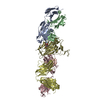 7m7wC 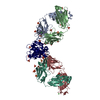 7r6wC 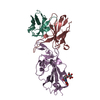 7r7nC 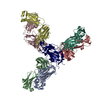 7jx3S 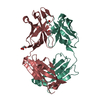 7k3qS C: citing same article ( S: Starting model for refinement |
|---|---|
| Similar structure data |
- Links
Links
- Assembly
Assembly
| Deposited unit | 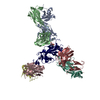
| ||||||||
|---|---|---|---|---|---|---|---|---|---|
| 1 |
| ||||||||
| Unit cell |
|
- Components
Components
-Antibody , 6 types, 6 molecules LHBADC
| #1: Antibody | Mass: 23369.947 Da / Num. of mol.: 1 Source method: isolated from a genetically manipulated source Source: (gene. exp.)  Homo sapiens (human) / Cell line (production host): HEK293.sus / Production host: Homo sapiens (human) / Cell line (production host): HEK293.sus / Production host:  Homo sapiens (human) Homo sapiens (human) |
|---|---|
| #2: Antibody | Mass: 23729.389 Da / Num. of mol.: 1 Source method: isolated from a genetically manipulated source Source: (gene. exp.)  Homo sapiens (human) / Cell line (production host): HEK293.sus / Production host: Homo sapiens (human) / Cell line (production host): HEK293.sus / Production host:  Homo sapiens (human) Homo sapiens (human) |
| #4: Antibody | Mass: 23204.697 Da / Num. of mol.: 1 Source method: isolated from a genetically manipulated source Source: (gene. exp.)  Homo sapiens (human) / Cell line (production host): HEK293.sus / Production host: Homo sapiens (human) / Cell line (production host): HEK293.sus / Production host:  Homo sapiens (human) Homo sapiens (human) |
| #5: Antibody | Mass: 24573.471 Da / Num. of mol.: 1 Source method: isolated from a genetically manipulated source Source: (gene. exp.)  Homo sapiens (human) / Cell line (production host): HEK293.sus / Production host: Homo sapiens (human) / Cell line (production host): HEK293.sus / Production host:  Homo sapiens (human) Homo sapiens (human) |
| #6: Antibody | Mass: 23546.127 Da / Num. of mol.: 1 Source method: isolated from a genetically manipulated source Source: (gene. exp.)  Homo sapiens (human) / Production host: Homo sapiens (human) / Production host:  |
| #7: Antibody | Mass: 24016.900 Da / Num. of mol.: 1 Source method: isolated from a genetically manipulated source Source: (gene. exp.)  Homo sapiens (human) / Production host: Homo sapiens (human) / Production host:  |
-Protein / Sugars , 2 types, 2 molecules R

| #3: Protein | Mass: 24442.332 Da / Num. of mol.: 1 / Fragment: receptor-binding domain (UNP residues 328-531) Source method: isolated from a genetically manipulated source Source: (gene. exp.)  Gene: S, 2 / Production host:  Homo sapiens (human) / References: UniProt: P0DTC2 Homo sapiens (human) / References: UniProt: P0DTC2 |
|---|---|
| #8: Sugar | ChemComp-NAG / |
-Non-polymers , 2 types, 5 molecules 


| #9: Chemical | | #10: Water | ChemComp-HOH / | |
|---|
-Details
| Has ligand of interest | N |
|---|---|
| Has protein modification | Y |
-Experimental details
-Experiment
| Experiment | Method:  X-RAY DIFFRACTION / Number of used crystals: 1 X-RAY DIFFRACTION / Number of used crystals: 1 |
|---|
- Sample preparation
Sample preparation
| Crystal | Density Matthews: 5.37 Å3/Da / Density % sol: 77.11 % |
|---|---|
| Crystal grow | Temperature: 293.15 K / Method: vapor diffusion, sitting drop Details: Crystal 1: 0.09 M phosphate/citrate, pH 5.5, 27% v/v PEG Smear Low, 4% v/v polypropylene glycol 400, 0.02 M imidazole, pH 7, Crystal 2: 0.09 M phosphate/citrate, pH 5.5, 27% v/v PEG Smear ...Details: Crystal 1: 0.09 M phosphate/citrate, pH 5.5, 27% v/v PEG Smear Low, 4% v/v polypropylene glycol 400, 0.02 M imidazole, pH 7, Crystal 2: 0.09 M phosphate/citrate, pH 5.5, 27% v/v PEG Smear Low, 0.01 M potassium/sodium phosphate, pH 7, 1% v/v PPGBA 230, 1.5% v/v PPGBA 400 |
-Data collection
| Diffraction | Mean temperature: 100 K / Serial crystal experiment: N | ||||||||||||||||||||||||||||||
|---|---|---|---|---|---|---|---|---|---|---|---|---|---|---|---|---|---|---|---|---|---|---|---|---|---|---|---|---|---|---|---|
| Diffraction source | Source:  SYNCHROTRON / Site: SYNCHROTRON / Site:  ALS ALS  / Beamline: 4.2.2 / Wavelength: 1.00003 Å / Beamline: 4.2.2 / Wavelength: 1.00003 Å | ||||||||||||||||||||||||||||||
| Detector | Type: RDI CMOS_8M / Detector: CMOS / Date: Oct 4, 2020 | ||||||||||||||||||||||||||||||
| Radiation | Protocol: SINGLE WAVELENGTH / Monochromatic (M) / Laue (L): M / Scattering type: x-ray | ||||||||||||||||||||||||||||||
| Radiation wavelength | Wavelength: 1.00003 Å / Relative weight: 1 | ||||||||||||||||||||||||||||||
| Reflection | Resolution: 2.93→49 Å / Num. obs: 77621 / % possible obs: 100 % / Redundancy: 28.9 % / CC1/2: 0.998 / Rmerge(I) obs: 0.295 / Rpim(I) all: 0.056 / Rrim(I) all: 0.3 / Net I/σ(I): 13.3 / Num. measured all: 2242103 | ||||||||||||||||||||||||||||||
| Reflection shell | Diffraction-ID: 1
|
- Processing
Processing
| Software |
| ||||||||||||||||||||||||||||||||||||||||||||||||||||||||||||||||||||||||||||||||||||||||||||||||||||||||||||||||||||||||||||||||||||||||||||||||||||||||||||||||||||||||||||||||||||||||||||||||||||||||
|---|---|---|---|---|---|---|---|---|---|---|---|---|---|---|---|---|---|---|---|---|---|---|---|---|---|---|---|---|---|---|---|---|---|---|---|---|---|---|---|---|---|---|---|---|---|---|---|---|---|---|---|---|---|---|---|---|---|---|---|---|---|---|---|---|---|---|---|---|---|---|---|---|---|---|---|---|---|---|---|---|---|---|---|---|---|---|---|---|---|---|---|---|---|---|---|---|---|---|---|---|---|---|---|---|---|---|---|---|---|---|---|---|---|---|---|---|---|---|---|---|---|---|---|---|---|---|---|---|---|---|---|---|---|---|---|---|---|---|---|---|---|---|---|---|---|---|---|---|---|---|---|---|---|---|---|---|---|---|---|---|---|---|---|---|---|---|---|---|---|---|---|---|---|---|---|---|---|---|---|---|---|---|---|---|---|---|---|---|---|---|---|---|---|---|---|---|---|---|---|---|---|
| Refinement | Method to determine structure:  MOLECULAR REPLACEMENT MOLECULAR REPLACEMENTStarting model: PDB entries 7JX3 and 7K3Q Resolution: 2.95→40 Å / Cor.coef. Fo:Fc: 0.922 / Cor.coef. Fo:Fc free: 0.906 / SU B: 33.532 / SU ML: 0.26 / Cross valid method: THROUGHOUT / σ(F): 0 / ESU R: 0.357 / ESU R Free: 0.282 / Stereochemistry target values: MAXIMUM LIKELIHOOD / Details: U VALUES : WITH TLS ADDED
| ||||||||||||||||||||||||||||||||||||||||||||||||||||||||||||||||||||||||||||||||||||||||||||||||||||||||||||||||||||||||||||||||||||||||||||||||||||||||||||||||||||||||||||||||||||||||||||||||||||||||
| Solvent computation | Ion probe radii: 0.8 Å / Shrinkage radii: 0.8 Å / VDW probe radii: 1.2 Å / Solvent model: MASK | ||||||||||||||||||||||||||||||||||||||||||||||||||||||||||||||||||||||||||||||||||||||||||||||||||||||||||||||||||||||||||||||||||||||||||||||||||||||||||||||||||||||||||||||||||||||||||||||||||||||||
| Displacement parameters | Biso max: 240.68 Å2 / Biso mean: 116.456 Å2 / Biso min: 58.09 Å2
| ||||||||||||||||||||||||||||||||||||||||||||||||||||||||||||||||||||||||||||||||||||||||||||||||||||||||||||||||||||||||||||||||||||||||||||||||||||||||||||||||||||||||||||||||||||||||||||||||||||||||
| Refinement step | Cycle: final / Resolution: 2.95→40 Å
| ||||||||||||||||||||||||||||||||||||||||||||||||||||||||||||||||||||||||||||||||||||||||||||||||||||||||||||||||||||||||||||||||||||||||||||||||||||||||||||||||||||||||||||||||||||||||||||||||||||||||
| Refine LS restraints |
| ||||||||||||||||||||||||||||||||||||||||||||||||||||||||||||||||||||||||||||||||||||||||||||||||||||||||||||||||||||||||||||||||||||||||||||||||||||||||||||||||||||||||||||||||||||||||||||||||||||||||
| LS refinement shell | Resolution: 2.95→3.026 Å / Rfactor Rfree error: 0 / Total num. of bins used: 20
| ||||||||||||||||||||||||||||||||||||||||||||||||||||||||||||||||||||||||||||||||||||||||||||||||||||||||||||||||||||||||||||||||||||||||||||||||||||||||||||||||||||||||||||||||||||||||||||||||||||||||
| Refinement TLS params. | Method: refined / Refine-ID: X-RAY DIFFRACTION
| ||||||||||||||||||||||||||||||||||||||||||||||||||||||||||||||||||||||||||||||||||||||||||||||||||||||||||||||||||||||||||||||||||||||||||||||||||||||||||||||||||||||||||||||||||||||||||||||||||||||||
| Refinement TLS group |
|
 Movie
Movie Controller
Controller





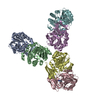
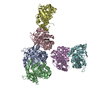
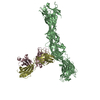
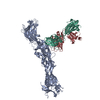

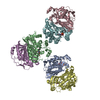
 PDBj
PDBj






